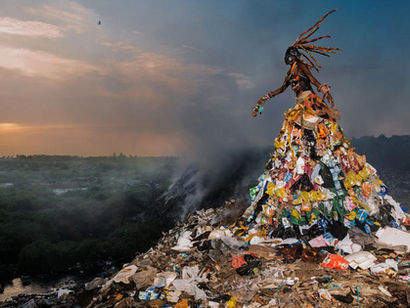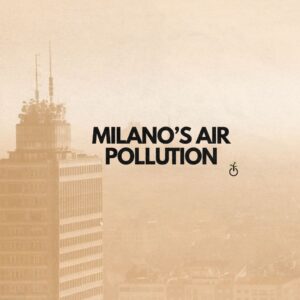Are we sure that buying a dress at a good price is really a deal?!
The fashion industry is the second largest polluter in the world just after the oil industry. Fast fashion, the mass production of cheap, low quality and short term clothing has become an integral part of consumers’ experience as a quick way to stay trendy without spending a fortune. Since the 21century countless new collections per year have been produced, latest trends have been developed and needs of customers have constantly been satisfied. Large brands such as Zara, Asos, H&M , Mango and Berksha have shifted from 4 seasonal collections to 20 different collections per year. Consumers tempted by the price buy stacks and stacks of clothes , aware that the cheap cost justifies the quickly replacement on the market and the short usage. Thanks to marketing strategies they even end up being scared of not finding their favourite clothes at the store anymore and the result is they end up buying them . This phenomenon by enhancing consumerism, has had a sizeable impact on the environment. The environmental costs although on a first look hidden , are HUGE! Let’s examine some of the consequences:
WATER CONSUMPTION:
Whilst about 100 million people in India do not have access to drinking water, 1.5 trillion liters of water are used by the fashion industry every single year. The United Nations have estimated a kg of cotton per a pair of jeans, which means 10,000 litres of water per kg of production. That number not only represents about 10 years worth of drinking water for one person but gives the reader a chance to reflect on the impact of fashion on a primary good such as water!! 2,6% of water is used to produce cotton, at a first glance it is a very small number, but when compared to 750 millions of people that don’t have access to water, this percentage suddenly appears a giant disproportion
GREENHOUSE GASES EMISSIONS OF THE FASHION INDUSTRY: The fashion industry is the third largest manufacturing sector followed by the automotive and technology industries, and is responsible for the 10% of annual carbon global emissions. Green house gases, generated by production, manufacturing and transportation of fashion industries. Synthetic fibers such as : Polyester, acrylic, nylon are all made from fossil fuels.
WORKING CONDITIONS: unfair wages and unhealthy working places are a reality. A must watch documentary: “The True Cost,” examines the business of fast fashion, scrutinizes the process every step of the way—from the overworked, underpaid factory workers in Bangladesh, to the American consumers who view cheap apparel as a disposable item, all the way through the effects of pollution in developing countries. To satisfy the growing demand of the new trends, the fashion businesses have to rely on low labour costs and the victims end up being all the workers of undeveloped countries.
CHEMICALS
Chemicals used in every part of the textile production (for making fibers, bleaching and dyeing fabrics) are one of the main components in our clothes. Those chemicals are absorbed by our skin even the ones made of “100% natural” fibers. These toxic substances put at risk not only human beings but also the aquatic ecosystem. Toxic substances such as mercury and arsenic , thrown in rivers can contaminate the sea and spread out around the globe.
SOILS DEGRADATION: soil fundamental in the ecosystem, has been damaged by fashion. The massive, global degradation of soil is one of the main environmental issues our planet is currently facing in terms of food security and global warming.
RAINFOREST DESTRUCTION: year after year, thousands of hectares of endangered and ancient forests are cut down and replaced by plantations of trees used to make wood-based fabrics such as rayon, viscose, and modal.
CONSUMERISM AND UNRECYCLED ITEMS: The clothing industry generates 92 million tons of waste. Doubtless 20 collections per yar can only have an effect: pushing consumers into buying the latest items to stay on trend. Less than 1% of of used clothing is recycled into new garments, whereas most are being burned or end up in landfills heavily polluting the environment and contributing to climate change. In addition, only a small fraction of plastics coming from the fashion’s packaging gets recycled. This simply leads to more emissions.
Is sustainable fashion possible?
Sustainable fashion can be defined as clothing that is ethically made and environmentally friendly, clearly the exact opposite of fast fashion. Fashion experts claim that “there is no such thing as being 100% sustainable with fashion” due to its toll on the environment.
“Green Brands”
• Stella McCartney a pioneer in the sustainable fashion, with her UK ethical luxury brand being launched in 2001.
• Mara Hoffman is another conscious designer who is trying to bring more sustainability into her brand.
• Patagonia, an American clothing company founded in the 70’s by Yvon Chouinard with the intent of revolutionizing the clothing industry.
The Green brands can be counted on a palm of hand! In fact what becomes crucial is the role of customers that needs to be educated. Buying less and from sustainable brands, buying second hand clothes, not throwing out clothes might be some solution to take into consideration! Certification programmes like the Better Cotton Initiative and Global Organic Textile Standard can enhance consumers find out how green their denim is . There are several ways to track the environmental progress of fashion brands, for example by checking international standards and certifications such as the Fashion Transparency Index or Good on You eco rating. As consumers, we should be supportive of brands that are transparent about their labor practices and future sustainable goals.
The fashion industry over the past 25 years has failed to reduce its impact on the environment and the reasons for those failed attempts to a sustainable revolution are all but easy to tackle. What mainly discourages brands is the high initial cost required for the transition to less impactful materials. There could always be room for improvements by adopting cruelty-free and environmentally friendly materials, switching to compostable packaging, or simply lowering the production.
Other solutions can be taken into action to mitigate these problems. The first step lies in building awareness and willingness to change. The power is in our hands. Image we decided to stop buying fast fashion, what would happen? Do you think brands will continue produce 20 collections per year? Let’s reflect.
Fashion is often said to both reflect and lead culture, the majority of the transition needs to be done by industrialised countries! It would be unthinkable to ask underdeveloped countries to use high quality materials! G7 countries have the chance to demonstrate that their attitude towards wealth is reflected also on the environment. Once again I restate that being 100% sustainable is an utopia even for brands such as Stella McCartney or Patagonia, but small steps can and will lead us to improvements.




